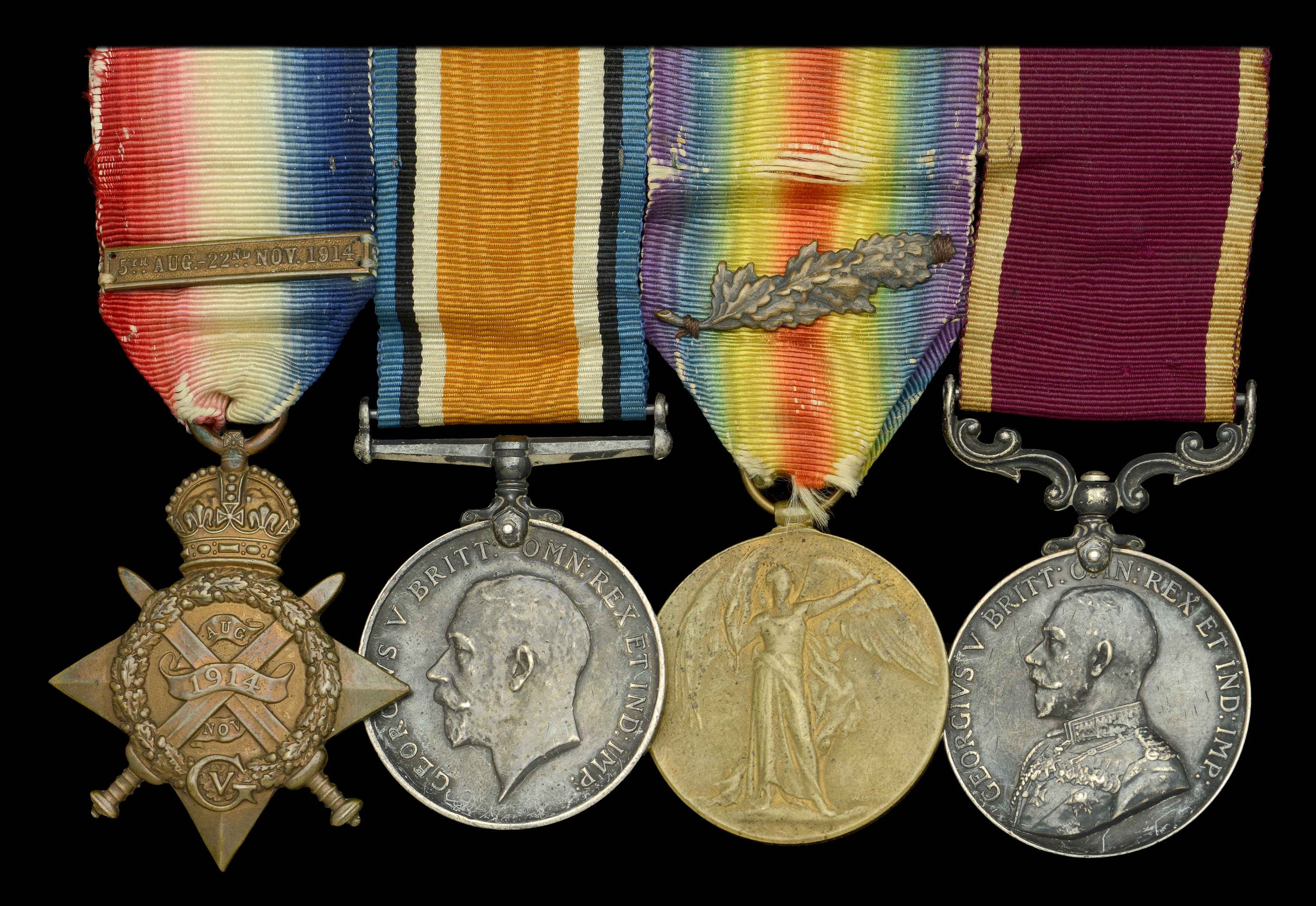Four: Staff Sergeant H. W. Jordan, 2nd Battalion, Royal Munster Fusiliers, who was wounded and taken prisoner of war at Etreux, the scene of his Battalion’s epic rearguard action during the retreat from Mons, on 27 August 1914 1914 Star, with clasp (9990 Pte. H. Jordan. R. Muns: Fus.); British War and Victory Medals, with M.I.D. oak leaves (9990 Pte. H. W. Jordan. R. Muns. Fus.); Army L.S. & G.C., G.V.R., 1st issue (7658070 S. Sjt. H. W. Jordan R.A.P.C.) mounted as worn, nearly very fine (4) £400-£500 --- M.I.D. London Gazette 30 January 1920. Horace Walter Jordan was born in 1885 at Camberwell, London and attested for the Royal Munster Fusiliers in 1913. Following the outbreak of the Great War, he disembarked with B Company of the 2nd Battalion at Havre on 14 August 1914 and moved forward to Mons where the battalion was held in reserve for the fighting on 24 August. During the retreat, the 2nd Munsters occupied the position of honour as rearguard to the 1st Guards Brigade which, in turn, acted as rearguard for the 1st Division commanded by Major General Lomax. On the morning of Thursday 27 August 1914, the Irishmen, supported by two 18-pounders of the 118th Battery R.F.A. and a troop of the 15th Hussars, held the villages of Fesmy and Bergues, together with two important road junctions in that immediate area. Approaching them in an arc from North to East was an entire German Army Corps preceded by masses of cavalry and backed by an impressive array of artillery. Early in the afternoon, having inflicted savage casualties on 12 battalions of the German 2nd Guards’ Reserve Division which had attacked Fesmy, the Munsters began to withdraw to the South to the village of Oisy, and on to Etreux. At 5.30pm the battalion was located at a crossroads just east of Oisy. Jordan’s “B” Company, however, was missing and the retreat was held up. The company reappeared at about 6.30pm but the delay, according to Captain McCance’s regimental history, proved ‘fatal to the battalion’. Approaching the village of Oisy, the battalion came under heavy fire from the houses on the northern outskirts, followed by salvoes from eight German field guns positioned south-east of the village. Now, for the first time, the Irishmen began to fall thick and fast and although the one remaining 18-pounder promptly came into action, its ammunition was nearly exhausted. After a series of desperate bayonet attacks, and with the artillerymen all dead and wounded about their gun, the gallant Munsters fell back to an orchard on the west of the road. Despite a further bayonet charge, at odds of fifty to one, which had temporarily held the enemy, the orchard was now ringed by Germans against whom the survivors, lining the four sides of the orchard, made every shot count. Ultimately, due to appalling casualties, lack of ammunition and the overwhelming superiority of enemy numbers, the survivors of the Battalion were compelled to surrender around 9pm. They had been fighting for 12 hours and their senior surviving officer was a Lieutenant but their sacrifice had ensured that Haig’s 1 Corps could continue unharassed on its way. Jordan was wounded in the heel and taken prisoner of war at Etreux on 27 August 1914. He was initially held at Gardelegen prisoner of war camp and was later sent to Merseburg. Upon his return to England after the war he was Mentioned in Despatches for valuable services rendered whilst a prisoner of war.
Auctioneer's Buyers Premium: 24% (+VAT)
Bidding on this auction using the-saleroom.com
There is an additional charge of 4.95% (+VAT/sales tax) when bidding on this auction using the-saleroom.com.
Please click here to read the Important Information for Buyer's on the auctioneer's website
See Full Terms And Conditions


